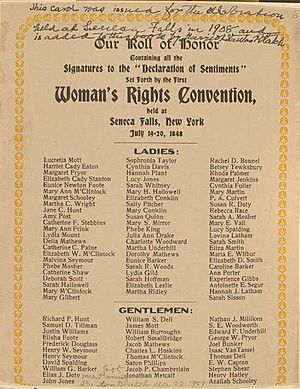Declaration of Sentiments facts for kids

The Declaration of Sentiments is a very important document from 1848. It was signed by 68 women and 32 men, making a total of 100 people. These people were attending the first women's rights meeting organized by women. This meeting, called the Seneca Falls Convention, took place in Seneca Falls, New York.
Elizabeth Cady Stanton was the main writer of the Declaration. She based it on the United States Declaration of Independence. Elizabeth Cady Stanton was a key organizer of the convention, along with Lucretia Coffin Mott and Martha Coffin Wright.
Frederick Douglass, a famous writer and speaker, attended the convention. His support helped the Declaration's ideas move forward. His newspaper, North Star, called the document a "grand movement" for women to gain their "civil, social, political, and religious rights."
Contents
What the Declaration Says
The Declaration of Sentiments starts by saying that women should have a different position in society than they had before. It states that this new position is what "the laws of nature and of nature's God entitle them."
We hold these truths to be self-evident: that all men and women are created equal; that they are endowed by their Creator with certain inalienable rights; that among these are life, liberty, and the pursuit of happiness; that to secure these rights governments are instituted, deriving their powers from the consent of the governed. Whenever any form of government becomes destructive of these rights, it is the right of those who suffer from it to refuse allegiance to it, and to insist upon the institution of a new government, laying its foundation on such principles, and organizing its powers in such form, as to them shall seem most likely to effect their safety and happiness.
The history of mankind is a history of repeated injuries and usurpation on the part of man toward woman, having in direct object the establishment of an absolute tyranny over her. To prove this, let facts be submitted to a candid world.
This part means that everyone, men and women, are born equal. They have rights that cannot be taken away, like the right to live, be free, and seek happiness. Governments are created to protect these rights. If a government stops protecting these rights, people have the right to change it. The Declaration says that men have treated women unfairly for a long time, trying to control them completely.
Complaints and Demands
The Declaration then lists many ways women were treated unfairly. These are called "sentiments" or grievances. Here are some of the main points:
- Women were not allowed to vote. This meant they had no say in the laws that affected them.
- If a woman was married, the law treated her as if she didn't exist as a person. She couldn't own property or even keep the money she earned.
- Laws about divorce were unfair to women. Men usually got to decide everything, including who got the children.
- Women were not allowed to get a good education. Most colleges were closed to them.
- Women were kept out of most jobs that paid well or were considered important, like being doctors, lawyers, or religious leaders.
- Society often had different rules for how men and women should behave. Things that were seen as wrong for women were often ignored for men.
- Men tried to make women feel less confident and less important. This made women feel like they had to depend on men.
A Call for Change
The Declaration ends by saying that because women were denied their rights and treated unfairly, they demand to be given "immediate admission to all the rights and privileges" that belong to them as citizens of the United States.
The people who signed the Declaration knew that their ideas might be misunderstood or even laughed at. But they were determined to use every tool they had to reach their goal. They planned to hire people to spread their message, hand out flyers, ask lawmakers for changes, and get support from churches and newspapers. They hoped the Seneca Falls Convention would be just the first of many such meetings across the country.
Who Signed the Declaration?
Many brave people signed the Declaration of Sentiments. Here are some of them:
- Lucretia Mott
- Harriet Cady Eaton - sister of Elizabeth Cady Stanton
- Elizabeth Cady Stanton
- Eunice Newton Foote
- Mary Ann M'Clintock
- Martha C. Wright - sister of Lucretia Mott
- Jane C. Hunt
- Amy Post
- Charlotte Woodward - She was the only signer who lived long enough to see the 19th Amendment passed, which gave women the right to vote. However, she was too ill to actually vote.
- Rhoda Palmer - She was the only woman signer who actually voted, in 1918, after New York allowed women to vote.
Some men also signed the Declaration, showing their support for women's rights:
- Richard P. Hunt - husband of Jane C. Hunt
- Frederick Douglass
- James Mott - husband of Lucretia Mott
- Thomas M'Clintock - husband of Mary Ann M'Clintock
- Jacob Chamberlain
See also
 In Spanish: Declaración de Seneca Falls para niños
In Spanish: Declaración de Seneca Falls para niños

